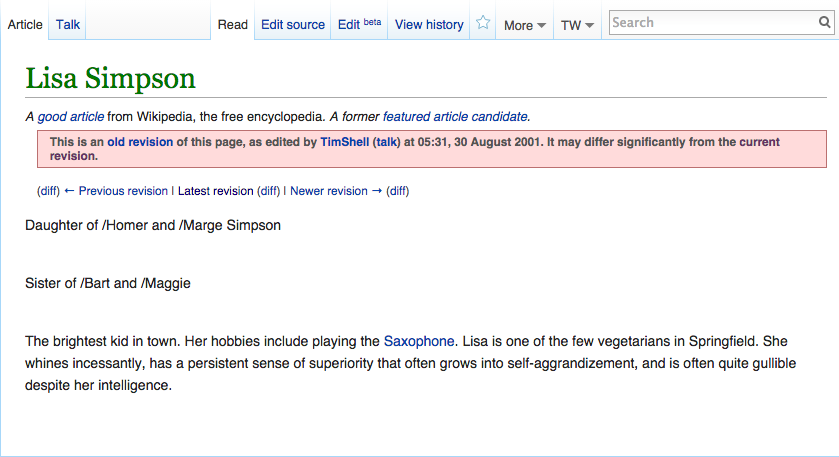
Wikis aren’t anything like other traditional forms of textual media. For one, they’re extremely transparent. In a wiki, as opposed to a book, we have access to the rich “archaeology” of a text. We can see who worked to compose it, what revisions it went through, and how it has changed from early drafts to more recent ones. Books, in some ways, are deceptive. They don’t reveal these secrets. They hide the messy process, the “shitty first drafts,” and lead us, and especially our students, into forgetting how writing is always recursive, collaborative, and of course, extremely messy.
This lesson plan uses the online encyclopedia Wikipedia, the most famous wiki, to teach a model of writing process and to open up discussions about how texts are composed, recursively and collaboratively. Articles in Wikipedia, and in many other wikis, feature a “History” function, where users can access previous versions of the text at hand, compare revisions, and get a sense of the development of the article over time. This is a particularly useful feature for collaborative writing, as nothing is ever lost, and editors can go back to previous versions of the article to restore content or compare it with newer content.
For compositionists, as has been recognized by researchers in our field , the history function also offers a unique opportunity for teaching writing process. Exposing students to the rich article histories on Wikipedia allows them a glimpse into the recursive and collaborative practices of a productive writing community. For instance, we can learn a great deal about the composition of the Lisa Simpson entry on Wikipedia by checking out its Revision History and some of the statistics generated from that history. As of today, Oct. 1 2014, the Lisa Simpson article has been revised 3,326 times by 1,637 different editors. Sure, some of these revisions have been minor grammatical changes or formatting, but many of them demonstrate the type of engaged revision we want to model for our students, revision that goes beyond superficial editing. Check out this comparison of edits made on May 31, 2006. Not only does this comparison show a significant and sizable revision made to the article, it also provides a glimpse into the conversation happening among editors. Radically transparent, right? Fascinating, too!
Lesson Goals & Learning Outcomes
This lesson is an opportunity to prompt discussions of writing process. As a result of this lesson, students should gain a more nuanced understanding of writing as a recursive, and often collaborative act. Students should better understand how texts are developed over time and often begin with a brief sketch or idea. Students should also become more familiar with digital methods of collaborative knowledge building in Wikipedia, and how those methods can inform their own writing.
Lesson Activities
- Introduce students to the “History” function in Wikipedia by using a projector to model an exploration of an article history. Simply click “View History” at the top right of an article. For this lesson, it’s best to use a highly developed entry that has a good amount of rich process.
- Clicking on this link will bring up a list of revisions that article has undergone. Each revision will have its own line and include information about the specific editor who made the revision, how much content was added, and the time and date the revision was made. Clicking on the time and date will allow you to view that specific revision of the article.
- Model some exploration for your students. Go back to the very first draft of the article, (see the screenshot of the first draft of “Lisa Simpson” below). Compare it to the most recent version.
- If students have access to computers or smart phones, have them explore some other article histories on their own. Ask them to look at original drafts and to compare revisions.

Discussion
After students explore article histories on their own, have them get into groups of 3-4 to share their findings and discuss the following:
- What articles did they examine?
- When were these articles first created?
- How do early drafts compare to more recent drafts?
- What was surprising or interesting about these article histories?
- In what ways did the article’s content develop over time?
- What can we learn about writing process from Wikipedia?
Give them about 10-15 minutes and then have students break out of groups and report back to the whole class on their discussion.
Try It Out, Start a Conversation
Try adding this lesson plan to a unit on process or digital media in a composition or rhetoric course. Share it with fellow instructors. Let us know how it works in the Comments section below. And tell us about some other ways you use wikis in the writing classroom.

2 Comments
Pingback: Wiki Wednesday: Using a Collaborative Classroom Wiki for Exam Study — Digital Rhetoric Collaborative
Pingback: Wiki Wednesday: A Roundup of Wiki Posts — Digital Rhetoric Collaborative